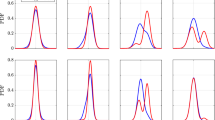Abstract
Some of the technical aspects of guidelines for key comparison data evaluation prepared by BIPM Director's Advisory Group on Uncertainties are considered. These guidelines relate to key comparisons based on the measurement of a travelling standard having good short-term stability and stability during transport, in cases where the institutes' measurements are realised independently. They include two procedures for forming a key comparison reference value (KCRV), and the associated uncertainty, and the consequent degrees of equivalence (including the associated uncertainties), in accordance with the Mutual Recognition Arrangement.
The basis of the procedures is (a) the representation of the information provided by the participating institutes as probability density functions (pdf), and (b) the estimator (model) used as the KCRV. The calculation of the KCRV and the associated uncertainty and the degrees of equivalence is then undertaken in accordance with the law of propagation of uncertainty, as described in the Guide to the Expression of Uncertainty in Measurement (GUM), or the propagation of distributions, a generalisation of the law of propagation of uncertainty, covered in a supplemental guide to the GUM.
Attention is paid to the choice of model, relating it to the conditions that apply to the key comparison. The first procedure is intended for cases where for each institute a Gaussian distribution is assigned to the measurand of which the institute's measurement is an estimate. The weighted mean is used as the model in this case. A consistency test is included to determine whether the model is consistent with the data. If the test is satisfied, the weighted mean is accepted as the KCRV. The second procedure is used in circumstances where (a) not all the pdf's assigned are Gaussian or (b) where the first procedure had previously been applied, the consistency test was not satisfied and there was no opportunity to correct all institutes' data regarded as discrepant. The model in this case is chosen to be a more robust estimator such as the median or another estimator considered appropriate for the particular comparison.
Similar content being viewed by others
REFERENCES
BIPM, Mutual Recognition of National Measurement Standards and of Calibration and Measurement Certificates Issued by National Metrology Institutes, Technical report, Bureau International des Poids et Mesures, Sèvres, France (1999).
BIPM, IEC, IFCC, ISO, IUPAC, IUPAP, and OIML, Guide to the Expression of Uncertainty in Measurement, Second Edition, ISBN 92-67-10188-9 (1995).
M. G. Cox, “The evaluation of key comparison data,” Metrolog., 39, 589-595 (2002).
M. G. Cox, “The evaluation of key comparison data: An introduction,” Metrolog., 39, 587-588 (2002).
M. G. Cox, M. P. Dainton, A. B. Forbes, P. M. Harris, P. M. Schwenke, B. R. L Siebert, and W. Wöger, “Use of Monte Carlo simulation for uncertainty evaluation in metrology,” in: P. Ciarlini, M. G. Cox, E. Filipe, F. Pavese, and D. Richter (eds.), Advanced Mathematical Tools in Metrology V. Series on Advances in Mathematics for Applied Sciences, Vol. 57, World Scientific, Singapore (2001), pp. 93-104.
M. G. Cox, M. P. Dainton, and P. M. Harris, Best Practice Guide No. 6. Uncertainty and Statistical Modelling, Technical Report, National Physical Laboratory, Teddington, UK (2001).
M. G. Cox, M. P. Dainton, and P. M. Harris, Software Specifications for Uncertainty Evaluation and Associated Statistical Analysis, Technical Report CMSC 10/01, National Physical Laboratory, Teddington, UK (2001).
M. G. Cox and E. Pardo, “The total median and its uncertainty,” in: P. Ciarlini, M. G. Cox, E. Filipe, F. Pavese, and D. Richter (eds.), Advanced Mathematical Tools in Metrology V. Series on Advances in Mathematics for Applied Sciences, Vol. 57, World Scientific, Singapore (2001), pp. 105-116.
JCGM. Guide to the Expression of Uncertainty in Measurement. Supplement 1: Numerical Methods for the Propagation of Probability Distributions, Technical report, Joint Committee for Guides in Metrology, Draft (2002).
K. V. Mardia, J. T. Kent, and J. M. Bibby, Multivariate Analysis, Academic Press, London (1979).
L. Nielsen, Evaluation of Measurement Intercomparisons by the Method of Least Squares, Technical Report DFM-99-R39, Danish Institute of Fundamental Metrology, Denmark (2000).
K. Weise and W. Wöger, “A Bayesian theory of measurement uncertainty,” Measurement Sci. Technol., 3, 1-11 (1992).
K. Weise and W. Wöger, “Removing model and data nonconformity in measurement evaluation,” Measurement Sci. Technol., 11, 1649-1658 (2000).
Author information
Authors and Affiliations
Rights and permissions
About this article
Cite this article
Cox, M.G., Harris, P.M. Technical Aspects of Guidelines for the Evaluation of Key Comparison Data. Measurement Techniques 47, 102–111 (2004). https://doi.org/10.1023/B:METE.0000022513.17564.5b
Issue Date:
DOI: https://doi.org/10.1023/B:METE.0000022513.17564.5b




